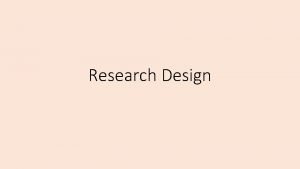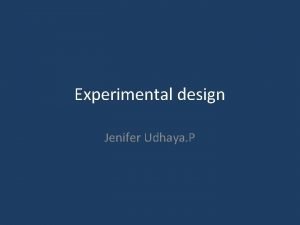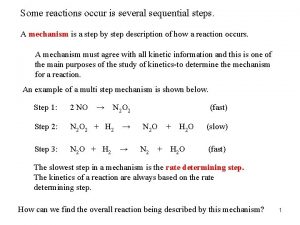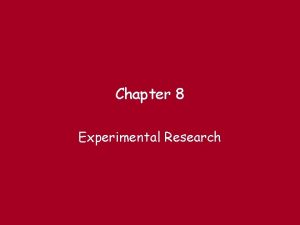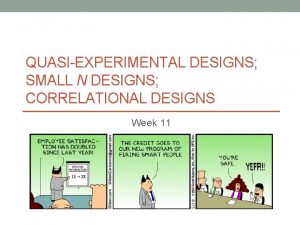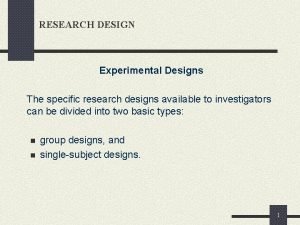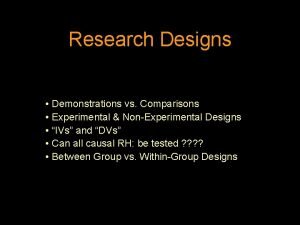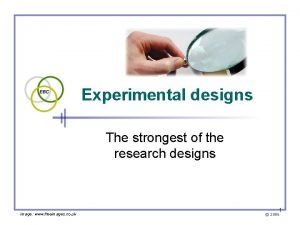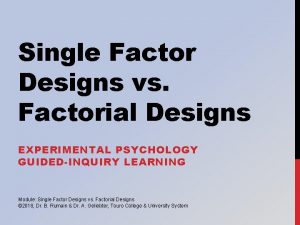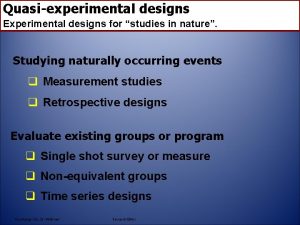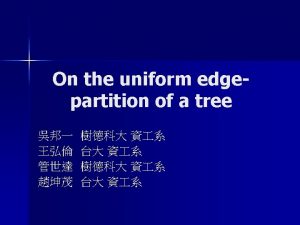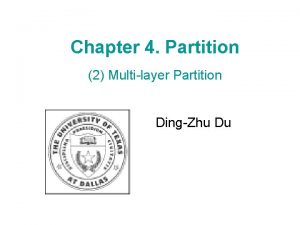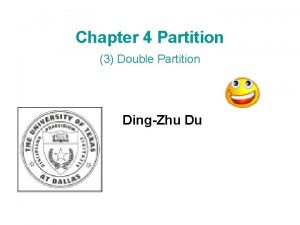Partition Experimental Designs for Sequential Process Steps Application




























- Slides: 28

Partition Experimental Designs for Sequential Process Steps: Application to Product Development Leonard Perry, Ph. D. , MBB, CSSBB, CQE Associate Professor & ISy. E Program Chair Industrial & Systems Engineering (ISy. E) University of San Diego 1

Example: Lens Finishing Processes n A company desires to improve their lens finishing process. Experimental runs must be limited due to cost concerns. Process One: Four Factors Process Two: Six Factors What type of design do you recommend? 2

Objective of Partition Designs n n To create a experimental design capable of handling a serial process consisting of multiple sequential processes that possess several factors and multiple responses. Advantages: q q q Output from first process may be difficult to measure. Potential interaction between sequential processes Reduction of experimental runs 3

Partition Design Matrix #1 Design Matrix #2 + Responses = 4

Partition Design: Assumptions n n Process/Product Knowledge required Screening Experiment required Resources limited, minimize runs Sparsity-of-Effect Principle 5

Partition Design: Methodology 1. 2. 3. 4. Perform Screening Experiment for Each Individual Process Construct Partition Design Perform Partition Design Experiment Perform Partition Design Analysis a) b) c) d) 5. Select Significant Effects for Each Response Build Empirical Model for Each Response Calculate Partition Intercept Select Significant Effects for Intercept Build Final Empirical Model 6

Review: Experimental Objectives n Product/Process Characterization q q q n Product/Process Improvement q q q n Find the setting for factors that create a desired output or response Determine model equation to relate factors and observed response Designs: 2 k Factorial, 2 k Factorial with Center Points Product/Process Optimization q q n Determine which factors are most influential on the observed response. “Screening” Experiments Designs: 2 k-p Fractional Factorial, Plackett-Burman Designs Determine an operating or design region in which the important factors lead to the best possible response. (Response Surface) Designs: Central Composite Designs, Box-Behnken Designs, D-optimal Product/Process Robustness q q Explore settings that minimize the effects of uncontrollable factors Designs: Taguchi Experiments 7

Example: First-order Partition Design n Two factors significant in each process q q n Total of k = 4 factors Potential Interaction between processes Partition Design q N = 5 runs (N = k - 1) (Saturated Design) 8

Step 1: Perform Screening Experiment n n Process 1: Significant Factors: q q Factor A Factor B n n Process 2: Significant Factors: q q Factor C Factor D 9

Step 2: Construct Partition Design n Partition Design: Design Criteria q First-order models n n n q Orthogonal D-optimal Minimize Alias Confounding Second-order models n n n D-efficiency G-efficiency Minimize Alias Confounding 10

Step 2: Construct Partition Design n First-order Design (Res III or Saturated) q q q Orthogonal D-optimality Minimize Alias Confounding 11

Step 2: Construct Partition Design Model Error Term A-A B-B C-C D-D Aliases BD CD ABC AB BC BD ABC ABD BCD AB AD BC BD ABC ABD BCD AB AC BCD 12

Step 3: Perform Partition Design Experiment n n n Planning is key Requires increased coordination between process steps Identification of Outputs and Inputs 13

Step 4: Perform Partition Design Analysis For Each Response: A. Select Significant Effects B. Build Empirical Model C. Calculate Partition Intercept Response D. Select Significant Effects for Intercept Response 14

Step 4 a: Select Significant Effects 15

Step 4 a: Select Significant Effects 16

Step 4 b: Build Empirical Model 17

Step 4 c: Calculate Partition Intercept Response Calculations Run 1 Int 1 i = - 8. 85 A - 16. 47 B + y 1 i for i= 1 to N Int 11 = - 8. 85(1) - 16. 47(1) + 34. 4 Int 11 = 9. 101 18

Step 4: Partition Analysis n Repeat for Second Partition A. B. C. Select Significant Effects Build Empirical Model Calculate Partition Intercept Response 19

Step 4 d: Select Significant Effects for Intercept 20

Step 5: Build Final Empirical Model 21

Case Study: Biogen IDEC • Q 8 Design Space – Link input parameters with quality attributes over broad range • Traditional Design of Experiments (DOE) – Systematic approach to study effects of multiple factors on process performance – Limitation: not applied to multiple sequential process steps; does not account for the effects of upstream process factors on downstream process outputs Controllable factors x 1 xk x 2 . . . Inputs Manufacturing Process #1 Outputs, y Inputs Manufacturing Process #2 z 2 Outputs, y . . . z 1 xk x 2 zr Uncontrollable factors z 1 z 2 zr Uncontrollable factors 22

Case Study: Biogen IDEC Partition Design: Experimental Controllable factors x 1 x 2 xk . . . Harvest p. H 4. 5 pool p. H 5. 75 pool p. H 7 pool Controllable factors x 1 x 2 z 2 xk . . . x 2 x 1 20 Protein-A eluate pools Protein-A . . . z 1 Controllable factors Uncontrollable factors z 1 z 2 20 CEX eluate pools . . . CIEX . . . zr xk . . . zr Uncontrollable factors z 2 z 1 zr Uncontrollable factors n Resolution IV: 1/16 fractional factorial for whole design n Each partition: full factorial n Harvest p. H included in Protein A partition n Each column: 16 expts + 4 center points = 20 expts 23

Partition Design: Designs Protein-A Chromatography Step Experiment Harvest p. H Load Capacity (%) 1 2 3 4 5 6 7 8 9 10 11 12 13 14 15 16 17 18 19 20 5. 75 4. 5 7 7 4. 5 7 5. 75 4. 5 7 5. 75 75 120 30 30 30 120 75 75 30 120 120 30 120 75 Wash I Conc. (m. M) 2100 0 0 0 0 4200 4200 2100 Elution velocity (cm/hr) Mab Eluate from Experiment # 262. 5 75 75 450 75 262. 5 450 75 450 450 262. 5 1 2 3 4 5 6 7 8 9 10 11 12 13 14 15 16 17 18 19 20 Cation Chromatography Step Elution Load Wash Na. Cl Capacity volume Conc. (%) (CV) (m. M) 70 3 155 110 2 185 30 4 185 110 2 185 30 2 125 110 4 185 110 2 125 30 2 185 70 3 155 4 110 125 30 4 185 30 2 125 30 4 125 110 2 125 110 4 185 70 3 155 Elution p. H 5. 5 6 6 5 5. 5 6 5. 5 24

CIEX Step HCP ANOVA Comparison: Main Effects Partition Model Results Traditional Model Results Input Parameter % of Total Sum of Squares Load HCP [f(Harvest p. H, Pro. A Wash I)] 83. 3 CIEX Elution p. H 6. 6 Load HCP 2 5. 8 Load HCP * Elution p. H 1. 6 CIEX Elution [Na. Cl] 1. 1 CIEX Elution p. H 2 0. 7 CIEX Elution [Na. Cl] * CIEX Elution p. H 0. 5 Load HCP * CIEX Elution [Na. Cl] 0. 2 CIEX Load Capacity 0. 1 R 2 0. 96 Input Parameter % of Total Sum of Squares Harvest p. H 32. 6 Pro A Wash I Conc. 17. 7 Harvest p. H * Pro A Wash I 15. 6 CIEX Elution p. H 10. 1 Harvest p. H * CIEX Elution p. H 8. 8 Pro A Wash I. * CIEX Elution p. H 4. 6 CIEX Load Capacity 3. 9 Pro A Wash I. Conc. * CIEX Elution Na. Cl 1. 8 CIEX Elution [Na. Cl] 1. 5 Harvest p. H * CIEX Elution [Na. Cl] 1. 2 CIEX Elution [Na. Cl] * CIEX Elution p. H 0. 2 Adjusted R 2 0. 95 R 2 0. 99 Predicted R 2 0. 92 Adjusted R 2 0. 99 Predicted R 2 0. 96 • Partition model identified same significant main factors and their relative rank in 25 significance

CIEX Step HCP ANOVA Comparison: Interactions Partition Model Results Traditional Model Results Input Parameter % Sum of Squares Input Parameter % of Total Sum of Squares Load HCP [f(A, C)] 83. 3 Harvest p. H 32. 6 CIEX Elution p. H 6. 6 Pro A Wash I Conc. 17. 8 Load HCP 2 5. 8 Harvest p. H * Pro A Wash I conc 15. 6 Load HCP * CIEX Elution p. H 1. 6 CIEX Elution p. H 10. 1 Elution [Na. Cl] 1. 1 Harvest p. H * CIEX Elution p. H 8. 8 Elution p. H 2 0. 7 Pro A Wash I. Conc. * CIEX Elution p. H 4. 6 Elution [Na. Cl] * CIEX Elution p. H 0. 5 CIEX Load Capacity 3. 9 Load HCP * CIEX Elution [Na. Cl] 0. 2 Pro. A Wash 1. * CIEX Elution Na. Cl 1. 8 SPXL Load Capacity (mg/ml) 0. 1 Elution [Na. Cl] 1. 5 Harvest p. H * CIEX Elution [Na. Cl] 1. 2 CIEX Elution [Na. Cl] * CIEX Elution p. H 0. 2 • Partition model able to identify interactions between process steps 26

Summary of Partition Designs Controllable factors x 1 x 2 x 1 xk x 2 Manufacturing Process #1 Outputs, y z 2 Inputs zr z 1 z 2 xk Inputs Manufacturing Process #3 Outputs, y . . . zr Uncontrollable factors z 1 z 2 zr Uncontrollable factors Experimental design capable of handling a serial process q n Outputs, y . . . Uncontrollable factors n x 2 . . . Manufacturing Process #2 . . . z 1 x 1 . . . Inputs Controllable factors xk Sequential process steps that possess several factors and multiple responses Potential Advantages q q 27 Links process steps together: identify upstream operation effects and interactions to downstream processes. Better understanding of the overall process Potentially less experiments No manipulation of uncontrollable parameters necessary

References n n n n D. E. Coleman and D. C. Montgomery (1993), ‘Systematic Approach to Planning for a Designed Industrial Experiment’, Technometrics, 35, 1 -27. Lin, D. J. K. (1993). "Another Look at First-Order Saturated Designs: The pefficient Designs, " Technometrics, 35: (3), p 284 -292. Montgomery, D. C. , Borror, C. M. and Stanley, J. D. , (1997). “Some Cautions in the Use of Plackett-Burman Designs, ” Quality Engineering, 10, 371 -381. Box, G. E. P. and Draper, N. R. (1987) Empirical Model Building and Response Surfaces, John Wiley, New York, NY Box, G. E. P. and Wilson, K. B. (1951), “On the Experimental Attainment of Optimal Conditions, ” Journal of the Royal Statistical Society, 13, 1 -45. Hartley, H. O. (1959), “Smallest composite design for quadratic response surfaces, ” Biometrics 15, 611 -624. Khuri, A. I. (1988), “A Measure of Rotatability for Response Surface Designs, ” Technometrics, 30, 95 -104. Perry, L. A. , Montgomery, and D. C, Fowler, J. W. , " Partition Experimental Designs for Sequential Processes: Part I - First Order Models ", Quality and Reliability Engineering International, 18, 1. 28
 11 principles of design
11 principles of design Experimental design
Experimental design Types of research design ppt
Types of research design ppt Basic principles of experimental design
Basic principles of experimental design Quasi-experimental research designs
Quasi-experimental research designs Quasi-experimental research designs
Quasi-experimental research designs Experimental vs non experimental
Experimental vs non experimental Descriptive studies
Descriptive studies Experimental vs non experimental research
Experimental vs non experimental research Experimental vs nonexperimental research
Experimental vs nonexperimental research Nonexperimental study
Nonexperimental study Sequential files in vb
Sequential files in vb Use the equation below to show the sequential steps
Use the equation below to show the sequential steps Steps in experimental research
Steps in experimental research What is axial movement
What is axial movement Kontinuitetshantering
Kontinuitetshantering Typiska novell drag
Typiska novell drag Nationell inriktning för artificiell intelligens
Nationell inriktning för artificiell intelligens Returpilarna
Returpilarna Varför kallas perioden 1918-1939 för mellankrigstiden?
Varför kallas perioden 1918-1939 för mellankrigstiden? En lathund för arbete med kontinuitetshantering
En lathund för arbete med kontinuitetshantering Personalliggare bygg undantag
Personalliggare bygg undantag Tidbok för yrkesförare
Tidbok för yrkesförare A gastrica
A gastrica Förklara densitet för barn
Förklara densitet för barn Datorkunskap för nybörjare
Datorkunskap för nybörjare Tack för att ni lyssnade bild
Tack för att ni lyssnade bild Debattartikel mall
Debattartikel mall Autokratiskt ledarskap
Autokratiskt ledarskap


